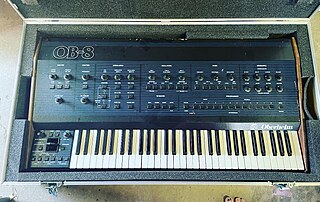
Modular synthesizers are synthesizers composed of separate modules for different functions. The modules can be connected together by the user to create a patch. The outputs from the modules may include audio signals, analog control voltages, or digital signals for logic or timing conditions. Typical modules are voltage-controlled oscillators, voltage-controlled filters, voltage-controlled amplifiers and envelope generators.

Oberheim is an American synthesizer manufacturer founded in 1969 by Tom Oberheim.

Novation Digital Music Systems Ltd. is a British musical equipment manufacturer, founded in 1992 by Ian Jannaway and Mark Thompson as Novation Electronic Music Systems. Today the company specializes in MIDI controllers with and without keyboards, both analog and virtual analog performance synthesizers, grid-based performance controllers, and audio interfaces. At present, Novation products are primarily manufactured in China.

The Jupiter-8, or JP-8, is an eight-voice polyphonic analog subtractive synthesizer introduced by Roland Corporation in early 1981.

The ARP Odyssey is an analog synthesizer introduced by ARP Instruments in 1972.

The Oberheim OB-X was the first of Oberheim's OB-series polyphonic analog subtractive synthesizers.

Waldorf Music is a German synthesizer company. They are best known for the Microwave wavetable synthesizer and Blofeld virtual analogue synthesizer.
Arturia is a French electronics company founded in 1999 and based in Grenoble, France. The company designs and manufactures audio interfaces and electronic musical instruments, including software synthesizers, drum machines, analog synthesizers, digital synthesizers, MIDI controllers, sequencers, and mobile apps.

The Access Virus is a virtual analog synthesizer made by the German company Access Music GmbH. It was first produced in 1997 and has since been upgraded frequently, with the company releasing new models about every two years. Early models include the Virus A, Virus B, and Virus C series, each available in various hardware configurations. In November 2005, the Virus TI series was released, including the 61-key Virus TI Keyboard and the 37-key Virus TI Polar. A small desktop model was released in February 2008 called the Virus TI Snow. A revision of the TI series called TI2 came out in March 2009, featuring faster digital signal processing (DSP) controllers, additional polyphony, more effects in the effect section and a slightly changed design. The Virus series also has come out with two software plugin versions: TDM for Pro Tools and VST for TC Electronic Powercore series. The term Access Virus can be used to refer to any one of these synthesizers.

The Moog Sonic Six is a duophonic analog synthesizer that was manufactured by Moog Music from 1972 to 1979. Because of its portable design and built-in speaker, the Sonic Six was widely used for lectures and educational purposes, often by Bob Moog himself.

The Doepfer A-100 is an analog modular synthesizer system introduced by German audio manufacturer Doepfer in 1995. Although there were only 10 module types at time of release, it currently has more than 120 modules plus several different enclosures and accessories.

The Oberheim OB-8 is a subtractive analog synthesizer launched by Oberheim in early 1983 and discontinued in 1985. As the fourth product in the OB-series of polyphonic compact synthesizers, the OB-8 was the successor to the OB-Xa. The number of production was about 3,000 units.

The Oberheim OB-Xa was the second of Oberheim's OB-series polyphonic analog subtractive synthesizers, replacing the OB-X with updated features.
The Roland JD-990 Super JD is a module version of Roland JD-800 synthesizer with expanded capabilities, which was released in 1993. JD-990 is a multitimbral synthesizer utilizing 'wave-table' sample-based synthesis technology. It is equipped with 6 MB of ROM containing sampled PCM waveforms, four sets of stereo outputs that are assignable to individual, internal, instruments, and standard MIDI in/out/through ports. JD-990 has a large LCD display and programming takes place through a keypad on the front panel of the unit. The unit can generate multi-timbral sounds reminiscent of the vintage analogue synthesizers but is also capable of generation of modern digital textures. There are several expansion boards available for JD-990 that can be installed in the provided expansion slot in the chassis of the unit.

The Oberheim Xpander is an analog synthesizer launched by Oberheim in 1984 and discontinued in 1988. It is essentially a keyboardless, six-voice version of the Matrix-12. Utilizing Oberheim's Matrix Modulation technology, the Xpander combined analog audio generation with the flexibility of digital controls logic.
The Roland MKS-80 Super Jupiter is a rack mount sound module version of the Roland Jupiter-6 and the Roland Jupiter-8 synthesizers. It is an 8-voice polyphonic analog synthesizer that was manufactured by Roland between 1984 and 1987. It is the only one of the MKS series of synthesizers to have analogue voltage-controlled oscillators (VCOs) instead of analogue digitally-controlled oscillators (DCOs). The voice architecture is almost identical to the Jupiter-6 synthesizer. The service manual states that "The module board of MKS-80 features the following in addition to that of JP-6, its brother module. 1) HPF. 2) Low boost circuit in the 2nd VCA. 3) DC supply current boost circuit (IC50)."

The Arturia MiniBrute is a synthesizer manufactured by Arturia. Although the MiniBrute was the first piece of analog hardware created by Arturia—which had previously exclusively marketed software synthesizers—it generated strong sales.
The history of home keyboards lies in mechanical musical instrument keyboards, electrified keyboards and 1960s and 1970s synthesizer technologies.
The RSF Kobol is a French monophonic synthesizer released in 1978, described by some as "the French Minimoog". It could process external sounds through the envelope and filter section. It was created by Ruben and Serge Fernandez. Fewer than 200 were made as they were not mass-produced. The Kobol is a very versatile instrument, offering many sought-after features of other analogue synthesizers of its time.

















